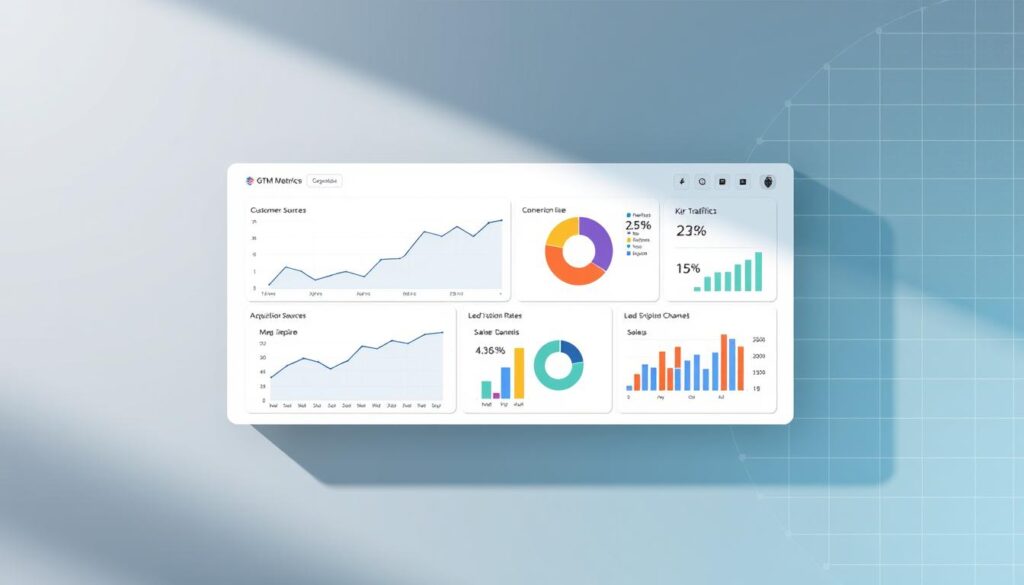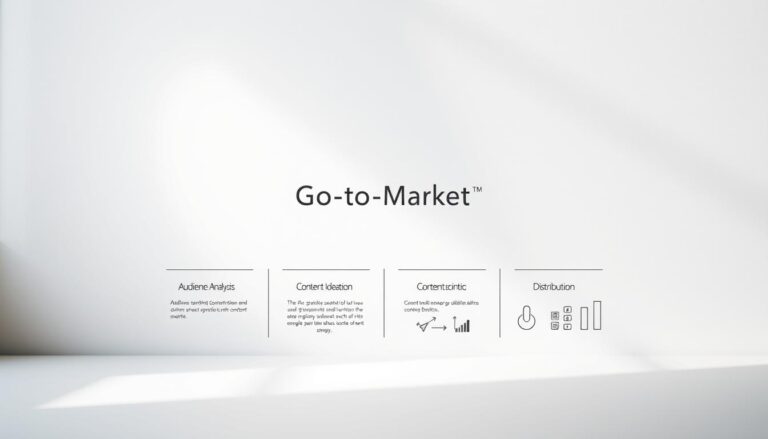To succeed today, businesses must constantly improve their Go-to-Market strategies. GTM optimization is vital as customer expectations rise and markets change quickly. With google tag manager best practices, companies can make smart decisions, use automation, and integrate tools to better engage customers and make sales smoother.
In this article, we’ll share tips on improving GTM tracking. Focusing on GTM optimization helps achieve quick wins and long-term growth. We’ll explore strategies and examples that show how optimizing GTM can lead to real success.
Key Takeaways
- Understanding GTM optimization’s importance is key for businesses.
- Using google tag manager best practices improves tracking and analysis.
- Addressing GTM optimization challenges is crucial for success.
- Effective team communication leads to better results.
- Listening to customer feedback is essential to refine GTM strategies.
Understanding GTM Effectiveness Optimization
GTM effectiveness optimization is about refining marketing and sales strategies for companies. It involves understanding what customers need. And then offering solutions that bring a good return on investment. Making customer experiences better is key, especially as competition changes.
Definition of GTM Effectiveness
Defining GTM effectiveness is about being able to launch a successful strategy. This strategy should match market trends and what consumers expect. Organizations good at this can quickly meet customer needs while being efficient.
Importance of Optimization in GTM
Optimization is very important. Companies that focus on making their GTM strategies better usually do better than their rivals. Since 80% of companies say customer experience is crucial for standing out, using tips for GTM can help stay relevant and adaptable.
Common Challenges in GTM Optimization
Many companies face difficulties in making their GTM strategies better. Common problems include:
- Misalignment among key teams, leading to inconsistent messaging and execution.
- Outdated processes that don’t meet today’s market needs.
- A lack of clear metrics, making success hard to measure.
- Not using resources efficiently, which slows down progress and results.
Key Metrics for Measuring GTM Success
To know if a go-to-market (GTM) strategy works, companies must watch key metrics closely. These metrics offer deep insights and help make smart choices. It’s all about knowing which metrics matter and using tools like gtm analytics to boost marketing success and overall results.
Essential Metrics to Track
There are several metrics that show how well GTM strategies are doing. They include:
- Lead conversion rates: Knowing how many leads become customers tells us a lot about our sales funnel’s success.
- Customer engagement levels: Watching how customers use products gives clues about how well products match market needs and user happiness.
- Campaign performance: Seeing how marketing campaigns do helps with planning resources better and improving future plans.
Tools for Measurement
Choosing the right tools is key for managing gtm containers well. Google Analytics helps understand user actions, showing how customers engage with websites and campaigns. Alongside, other specialized tools add to gtm analytics with unique data and more ways to improve.
Analyzing Data for Insights
Analyzing data carefully is key to finding useful tips from collected metrics. Combining different data helps understand customer actions and market changes better. This process helps spot valuable accounts, fine-tune target audiences, and tweak marketing methods for improved results.

Strategies for Enhancing GTM Effectiveness
Boosting GTM effectiveness involves several key steps. These include better communication, using technology wisely, and never stopping learning. By doing this, teams can work well together. They can also make the most of the tools they have. This helps achieve greater outcomes and stay up-to-date with market shifts.
Streamlining Communication Between Teams
Good communication between sales, marketing, and customer teams lowers issues and boosts teamwork. Having regular meetings helps everyone stay focused on their goals. Using gtm tagging helps monitor how users behave and see trends. This info helps the teams make smart choices and face challenges together.
Leveraging Technology for Better Outcomes
Using modern tech, like automation, makes work easier. With tools for checking gtm tags in real-time, teams can find and fix problems fast. This way, everyone can concentrate on important tasks that match the company’s aims. By improving how gtm tracking works, we ensure the data we get is correct and useful.
Continuous Learning and Feedback Loops
Learning all the time is crucial for any team. Through feedback, teams can tweak their GTM plans based on fresh customer feedback and market trends. Workshops and training boost understanding of gtm tagging methods. Reviewing performance regularly shows where to get better.
| Strategy | Description | Benefits |
|---|---|---|
| Communication | Regular interactions among teams | Reduces inefficiencies and aligns objectives |
| Technology | Use of automation and tools | Boosts productivity and enhances accuracy |
| Learning | Continuous feedback and training | Fosters adaptation to market dynamics |
To really make GTM work better, putting these strategies into action is key. For more ideas on making your work process smoother, check out workflow optimization techniques. They offer great ways to make your operations more efficient and improve performance.
Role of Customer Feedback in GTM Optimization
Customer feedback is key in improving go-to-market strategies. It helps companies understand what their customers need. This way, they can make their customer experience better and succeed in the market. Collecting and using customer insights makes their products match what people really want.
Methods for Collecting Customer Feedback
- Surveys: Short questionnaires distributed to customers can reveal valuable opinions and preferences.
- Focus Groups: Conducting discussions with select customers helps delve deeper into specific issues and gather qualitative data.
- Online Reviews: Analyzing customer comments on platforms like Yelp or Google can provide insights into customer satisfaction and product perception.
- Social Media Listening: Monitoring conversations on social media offers real-time insights into consumer thoughts and trends.
Integrating Customer Insights into GTM Strategy
Using customer feedback helps optimize GTM strategies. Companies can adjust their messaging and product features based on what customers really think. This makes marketing campaigns more effective. Making these changes leads to stronger relationships with customers and builds loyalty.
| Feedback Method | Advantages | Challenges |
|---|---|---|
| Surveys | Quick data collection, broad reach | Poor response rates, potential bias |
| Focus Groups | In-depth insights, interpersonal interactions | Time-consuming, not always representative |
| Online Reviews | Real-time customer thoughts, wide audience | Negative reviews can skew perception |
| Social Media Listening | Immediate feedback, trends spotting | Information overload, interpretation challenges |

Case Studies: Successful GTM Optimization
Looking closely at certain case studies, we see different ways companies have boosted their gtm strategies. Businesses in various industries have taken specific actions to improve their go-to-market plans. These actions have led to impressive success stories and important learning moments.
Industry Examples of Effective GTM Strategies
Salesforce is a great example, as it brought its marketing and sales teams closer. By using detailed data analysis, it spotted trends that helped make customer talks more personal. This boost in interaction greatly increased their number of customers. Their focus on using data for decisions was key in quickly adapting to new market needs.
Spotify also saw great results by figuring out what their users liked. They changed their marketing approach by listening to user feedback. Spotify then created playlists just right for each listener, keeping them happy and subscribed. Their journey shows just how reshaping your gtm strategy with customer feedback can lead to success in the digital world.
Lessons Learned from Failures
However, not every story is a win. Take Blockbuster, for example, which didn’t move quickly enough into the digital world. By sticking to its old gtm strategy and ignoring the growth of streaming, it ended up going bankrupt. This tells us ignoring innovation and what customers want can have serious downsides in a fast-changing market.
On another note, Toys “R” Us didn’t make the most of online sales in their strategy. Their slow move to e-commerce, while others sped by, cost them greatly. This cases teach us the importance of being quick and flexible in updating our gtm strategies.
Future Trends in GTM Effectiveness Optimization
The way businesses improve their GTM (Go-To-Market) strategy is changing fast. AI and automation are big trends changing this field. These tools help companies do marketing better, make smarter decisions, and reach the right people more effectively.
Impact of AI and Automation
Automation lets businesses process and understand data very quickly. This helps them make custom experiences for customers. Adapting to these technologies improves a company’s competitive advantage. This means better customer experiences. AI also finds important insights in big data sets. This helps improve GTM strategies.
Evolving Consumer Behavior and its Implications
Businesses need to keep up with changing consumer behavior. People now want personalized service and expect brands to know their needs. This means companies need to focus on communications that really speak to people. Using new technologies helps companies meet these expectations and deal with complex customer journeys.
Preparing for Changes in the Market Landscape
Staying ahead of market changes is key for long-term success. Using new technologies and updating marketing strategies helps companies stay flexible. Being proactive with these changes boosts GTM effectiveness and increases brand loyalty and market share. For more ideas, look at how Adobe and Hexagon worked with Demandbase. You can learn a lot from their experience.
FAQ
What is GTM effectiveness?
GTM effectiveness means being really good at using marketing and sales plans to get the best return on investment. It’s about making those plans fit what customers want and need today.
Why is optimizing the GTM strategy important?
Making your GTM strategy better is key because staying ahead in a world where the customer’s experience is everything is crucial. By updating strategies, companies can keep up with new market trends and what customers like.
What are common challenges in GTM optimization?
The usual hurdles are when teams aren’t working together, using old ways, not knowing the important numbers, and not using resources well. Getting past these issues is needed to make GTM work well and grow over time.
What metrics should businesses track to measure GTM success?
Businesses should look at how well they turn leads into customers, how engaged their customers are, and how their campaigns are doing. Keeping an eye on these things helps them see if their strategies work and make better plans using facts.
What tools can help measure GTM success?
Tools like Google Analytics and Google Tag Manager (GTM) are great for understanding how things are going. They help by putting together different kinds of data, giving a full picture of what customers do and want.
How can businesses enhance their GTM effectiveness?
Companies can do better in GTM by making sure sales, marketing, and customer success teams talk well to each other, using technology to do things automatically, and always learning from feedback.
Why is customer feedback important in GTM optimization?
Hearing from customers is key for making GTM strategies better because it tells companies what customers really think and want. This info helps in making messages that speak to customers, improving plans, and meeting customer expectations.
Can you provide examples of successful GTM optimization strategies?
Some winning moves in GTM are getting sales and marketing to work as one, using facts to make decisions, and keeping up with what’s new in the market. Looking at real stories shows how different fields have dealt with familiar problems.
What future trends could impact GTM effectiveness?
Looking ahead, AI and making things automatic could make marketing smarter and choices better. As what customers want changes, businesses have to change too, aiming for marketing that feels personal and talks directly to them.



